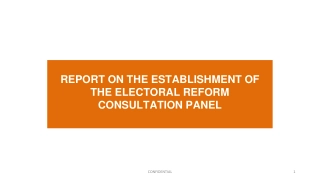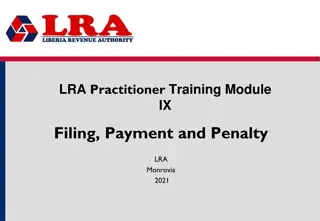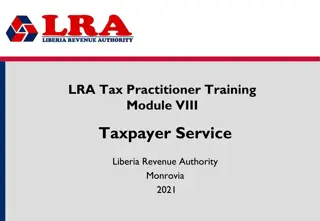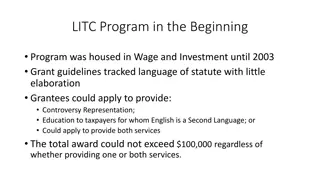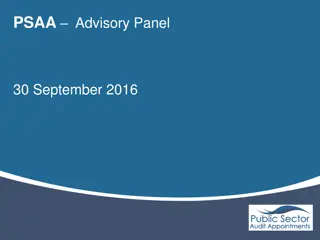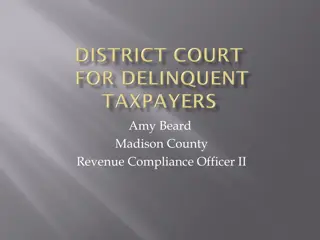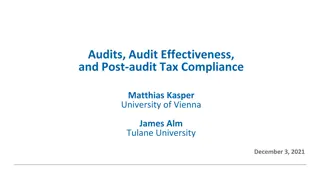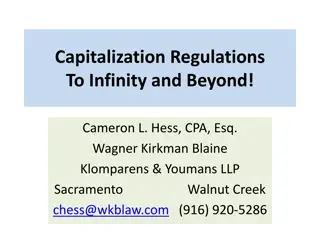
Understanding Australian Anti-Avoidance Provisions in Taxation Law
Explore the Australian perspective on anti-avoidance provisions in taxation law, focusing on Part IVA overview, company tax rates, legislative framework, and application of these provisions. Learn about recent developments, multinational tax reporting, and the significance of these regulations in combatting tax avoidance practices.
Download Presentation

Please find below an Image/Link to download the presentation.
The content on the website is provided AS IS for your information and personal use only. It may not be sold, licensed, or shared on other websites without obtaining consent from the author. If you encounter any issues during the download, it is possible that the publisher has removed the file from their server.
You are allowed to download the files provided on this website for personal or commercial use, subject to the condition that they are used lawfully. All files are the property of their respective owners.
The content on the website is provided AS IS for your information and personal use only. It may not be sold, licensed, or shared on other websites without obtaining consent from the author.
E N D
Presentation Transcript
PRESENTATION TOPIC Tony Greco, General Manager of Technical Policy for Institute Public Accountants, Australia Ulaanbaatar, Mongolia, 2018
Part IVA Overview Australian Perspective Overview Brief introduction Anti Avoidance Provisions Recent developments Multinationals Country by country reporting Hybrid Mismatches Litigation trend 01
Part IVA Overview Australian Perspective Company tax rates Legislated tax cuts for companies with turnover $50M 27.5% and will phase down to 25% by 2026-27 Current debate to reduce company tax rate from 30% to 25% for all companies by 2026-27 Unlikely to proceed 3rd highest in the world (Asian average 21%, Hong Kong 16.5%, Singapore 17%,) UK moving to 17% and USA 21% Even if we succeed 25% by 2026-27 still not competitive 03
Anti Avoidance Provisions Anti Avoidance Part IVA has been in place in Australia for 37 years enacted in 1981 Tweaked in 2013 Tax benefit hypothesise as to what might reasonably have occurred but for the scheme/what might have reasonably be expected to have occurred if the arrangement was structured differently but achieved same result) Amendments not yet tested in courts There is always some uncertainty of it application especially now since it was tweaked Tax advisers seek guidance from case law and Australian Taxation Office (ATO) ATO must apply Part IVA anti avoidance provisions Provision of last resort 03
Anti Avoidance Provisions Legislative Framework A taxpayer enters into a scheme The taxpayer obtains a tax benefit Circumstances indicate that the obtaining of that tax benefit was the dominant purpose (work through eight factors to determine sole or dominant purpose) Blatant, artificial or contrived If Part IVA applies to the scheme, the Commissioner may cancel the tax benefit, make compensating adjustments and impose substantial penalties 03
Anti Avoidance Provisions Not intended to apply on normal commercial transactions by which taxpayers legitimately take advantage of opportunities available for the arrangement of their affairs Tax planning beyond the scope of Part IVA Part IVA gives effect to this distinction by requiring an examination of whether, having regard to eight objective matters, it would be concluded that the arrangement was entered into in the particular way it was for the sole or dominant purpose of obtaining a tax advantage 03
Anti Avoidance Provisions The application of the General Anti-Avoidance Rules (GAAR) is a serious matter acknowledge that a GAAR should be applied only after careful and full consideration of the facts ATO have established the GAAR Panel (the Panel) to advise on the application of GAARs to particular arrangements The Panel helps the ATO in the administration of the GAARs by providing independent advice to the ATO on matters referred to it 03
Multi National Tax Integrity Measures Diverted profits tax (DPT) have permanent presence Multinational Anti-Avoidance Law (MAAL) no permanent presence Hybrid Mismatch legislation proposed Thin Capitalisation changes Digital Tax looming digital advertising 03
Diverted profits tax Diverted profits tax (DPT) The DPT came into effect on 1 July 2017 and imposes a 40% tax The DPT aims to ensure that the tax paid by significant global entities (SGEs) properly reflects the economic substance of their activities in Australia aims to prevent the diversion of profits offshore through arrangements involving related parties encourages greater compliance by large multinational enterprises with their tax obligations in Australia, including Australia's transfer pricing rules 03
Multinational Anti-Avoidance Law (MAAL) The MAAL came into effect on 11 December 2015 The multinational anti-avoidance law is designed to counter the erosion of the Australian tax base by multinational entities using artificial or contrived arrangements to avoid the attribution of business profits to Australia through a taxable presence in Australia 03
Multinational Anti-Avoidance Law (MAAL) Broadly, the new law will apply if under the scheme, or in connection with the scheme: a foreign entity supplies goods or services to an Australian customer an Australian entity, that is an associate of or is commercially dependent on the foreign entity, undertakes activities directly in connection with the supply some or all of the income derived by the foreign entity is not attributable to an Australian permanent establishment, and the principal purpose, or one of the principal purposes of the scheme, is to obtain an Australian tax benefit or to obtain both an Australian and foreign tax benefit 03
Multinational Anti-Avoidance Law (MAAL) Under the MAAL we can cancel any tax benefits an SGE, and its related parties, obtained from certain schemes described above. SGEs are also subject to increased penalties for tax shortfalls arising from the application of the MAAL Any multinationals that are found to be avoiding Australian tax under the new law will have to pay back the tax they owe (plus interest) and face penalties of up to 100 per cent of the tax owed 03
Country-by-Country reporting Australia has adopted Action 13 BEPS Action 13 of the G20 and Organisation for Economic Co-operation and Development s Action Plan on Base Erosion and Profit Shifting, which concerns transfer pricing documentation and Country-by- Country reporting, into Australian domestic law. Country-by-Country reporting will provide the Australian Taxation Office (ATO) with a global picture of how multinationals operate. This will allow the ATO to better assess transfer pricing risks and allocate audit resources more efficiently 03
Hybrid Mismatch Rules Government has issued draft legislation implementing the OECD Hybrid Mismatch Rules (Likely legislation will proceed) The rules are intended to prevent entities (including multinational corporations) liable to income tax in Australia from being able to structure income taxation, or obtain a double non-taxation benefit, but exploiting differences between the tax treatment of entities and instruments across countries The broad aim of the legislation is to provide that where a hybrid mismatch occurs, an amount equal to the mismatch may not be deducted from Australian taxable income Double deduction (or double non-inclusion) is the holy grail of aggressive tax structuring 03
Thin Capitalisation Changes More tweaks for thin capitalisation aimed at multinationals Align the value of their assets for thin capitalisation purposes with value in financial statements Double gearing structures lower the associate entity threshold form 50 per cent to 10 per cent Treat foreign controlled Australian consolidated entities and multiple entry consolidated groups that control a foreign entity are treated as both outward and inward vehicles for thin capitalisation purposes 03
Change approach Disputes The ATO change in approach to disputes is showing up in ATO data on litigation The numbers reflect a shift under the leadership of our current tax commissioner Chris Jordan from a predominantly compliance model to one that is client-centric and based on good management The ATO wants to see an end to taxpayers starting litigation to get a dispute underway emphasis on resolving disputes early to save both the ATO and taxpayer time and money and also give the taxpayer certainty going forward 03
Change approach Disputes ATO wants to see advisers using the in-house facilitation service, as it has a high success rate in narrowing and resolving issues in dispute In-house facilitation is proving to be successful with small businesses, who see it as cost-effective and a timely way to resolve disputes Settlements are defined as agreements that involve a compromise, or a resolution when one or all parties make concessions on what they consider is the legally correct position It might involve an amended assessment with a payment arrangement and an agreed time frame 03

